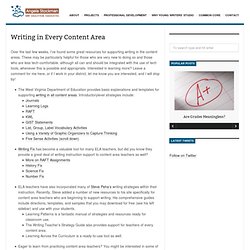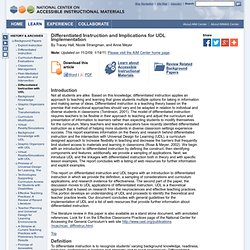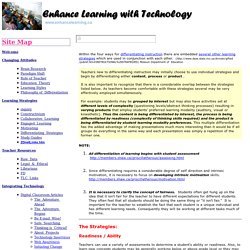

Differentiation Strategies. Covington Cove. WNY Education Associates » Writing in Every Content Area. Over the last few weeks, I’ve found some great resources for supporting writing in the content areas.

These may be particularly helpful for those who are very new to doing so and those who are less tech-comfortable, although all can and should be integrated with the use of tech tools, whenever this is possible and appropriate. Interested in learning more? Leave a comment for me here, or if I work in your district, let me know you are interested, and I will stop by! ELA teachers have also incorporated many of Steve Peha’s writing strategies within their instruction. Recently, Steve added a number of new resources to his site specifically for content area teachers who are beginning to support writing. Differentiated Instruction and Implications for UDL Implementation. By Tracey Hall, Nicole Strangman, and Anne Meyer Note: Updated on 11/2/09; 1/14/11; Please visit the AIM Center home page.

Introduction Not all students are alike. Based on this knowledge, differentiated instruction applies an approach to teaching and learning that gives students multiple options for taking in information and making sense of ideas. Differentiated instruction is a teaching theory based on the premise that instructional approaches should vary and be adapted in relation to individual and diverse students in classrooms (Tomlinson, 2001). This report on differentiated instruction and UDL begins with an introduction to differentiated instruction in which we provide the definition, a sampling of considerations and curriculum applications, and research evidence for effectiveness.
The literature review in this paper is also available as a stand alone document, with annotated references. Top Definition Figure 1. Identifying Components/Features Content Process Products Figure 2. Differentiated Instruction. Strategies for Differentiating. Within the four ways for differentiating instruction there are embedded several other learning strategies which are used in conjunction with each other.

The Strategies: Readiness / Ability Teachers can use a variety of assessments to determine a student's ability or readiness. Also, to learn new concepts students may be generally working below or above grade level or they may simply be missing necessary prerequisite skills. However, readiness is constantly changing and as readiness changes it is important that students be permitted to move between different groups (see flexible grouping). Varying the level of questioning (and consequent thinking skills) and compacting the curriculum and are useful strategies for accommodating differences in ability or readiness. Adjusting Questions During large group discussion activities, teachers direct the higher level questions to the students who can handle them and adjust questions accordingly for student with greater needs.
Compacting Curriculum. RTEC Exchange. RTEC at WestEd has worked in partnership with the Alliance for Technology Access to create this website, a Powerpoint presentation, handouts for each tip, and more. The site has migrated to www.wested.org/tdl . Technology Tips are: focused on technologies most schools already have for use in professional development of technology - for general and special educators, and staff Training on this topic is available through WestEd and can include customization for any group or grade level hands-on activities correlation with adopted materials a PDF tip sheet for each tip.